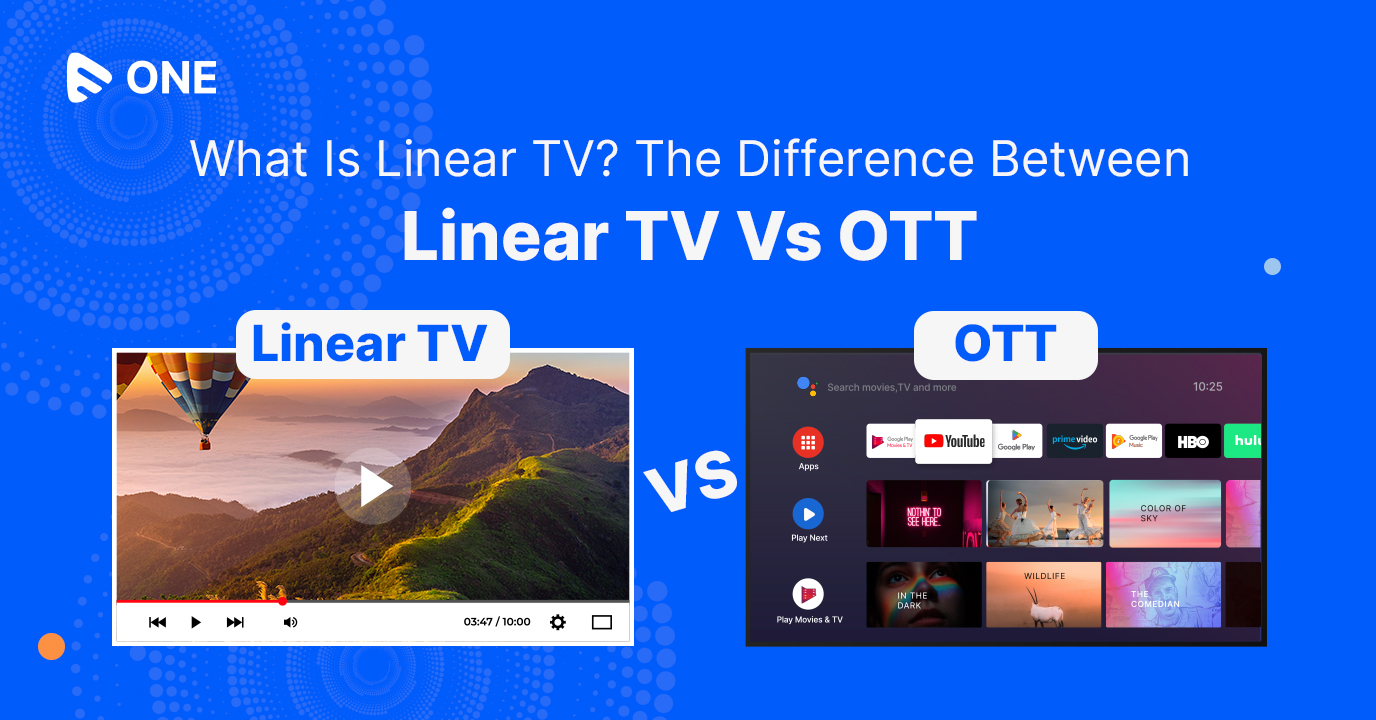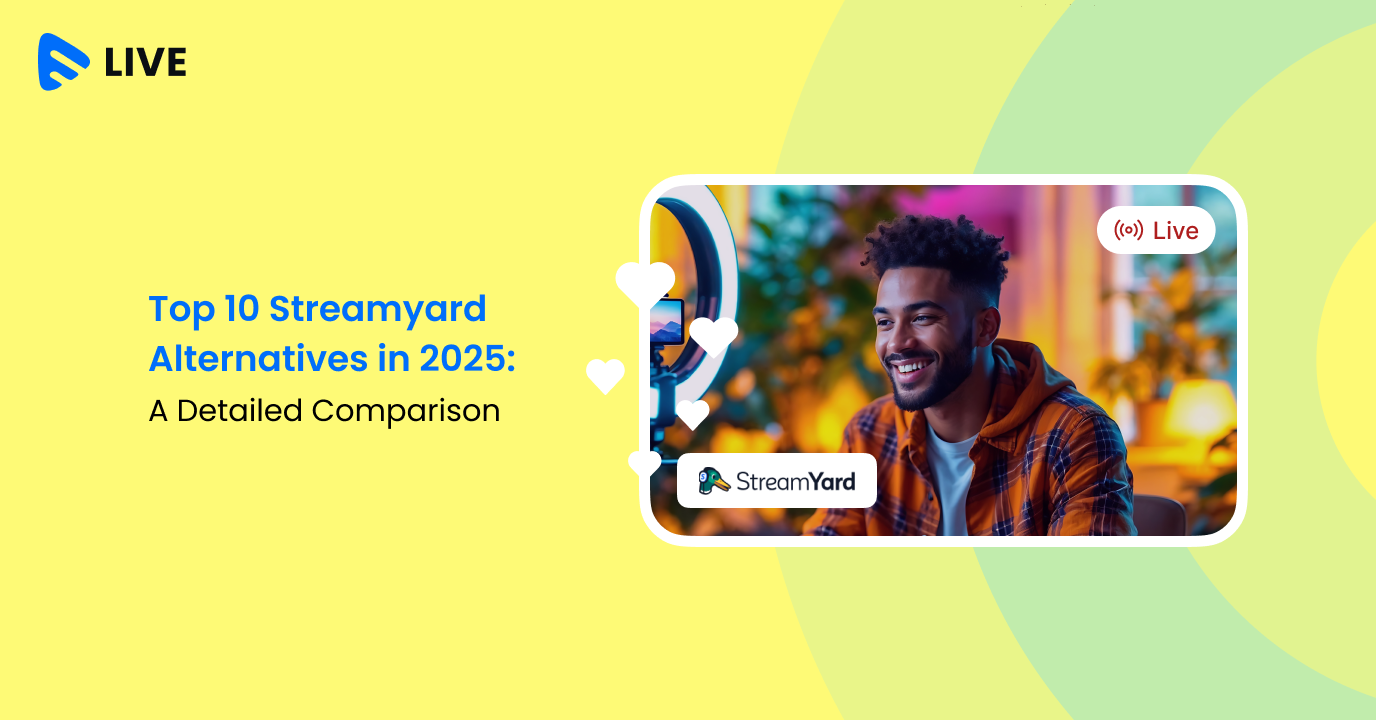Are you a streaming business seeking clarity amidst the ever-evolving streaming landscape?
Wondering about the fundamental concepts of Linear TV and OTT services?
In today’s media industry, understanding the difference between these two broadcasting approaches is vital. While Linear TV adheres to a traditional schedule via cable or satellite providers, OTT delivers on-demand content directly over the internet.
As the streaming industry continues to shape viewer preferences, this introduction to Linear TV and OTT will provide valuable insights, helping you captivate the right audience and stay ahead amidst this fierce competition.
So, read on to gain more valuable insights as we delve deeper into the concept of linear TV vs OTT.
What Is Linear TV?
Linear TV, also known as traditional television or scheduled television, refers to the conventional broadcasting method where television channels air programs according to a fixed schedule. Linear television operates similarly, providing a structured viewing experience that contrasts with the flexibility of on-demand services.
In this format, viewers tune in to watch content as it is being transmitted by broadcasters over cable, satellite, or terrestrial networks. Unlike on-demand services, such as streaming platforms, where viewers can choose what to watch and when, Linear TV offers a pre-determined lineup of shows and broadcasts that follows a set timetable.
This mode of television consumption has been prevalent for decades and is typically associated with traditional cable or satellite subscriptions.
While Linear TV remains popular in many regions, the rise of OTT platforms and internet streaming services has led to a shift in viewers’ preferences, allowing them to enjoy content on a more flexible and personalized basis.
How Linear TV Works
Linear TV operates by broadcasting television programs on specific channels at scheduled times. This traditional broadcasting model relies on a one-to-many distribution system, where content is created and produced by broadcasting companies and then transmitted to a large audience simultaneously. The process begins with the encoding of television shows, movies, news, and other content into radio frequency signals or digital signals, depending on the transmission technology used.
These signals are then transmitted from the broadcasting station to various distribution networks, including terrestrial antennas, satellite dishes, and cable networks. Viewers with television sets and the necessary receiving equipment, such as antennas or satellite dishes, can access these signals and watch the content being broadcasted. This method ensures that viewers can tune in to their favorite programs at specific times, following a set schedule.
The traditional broadcasting model of Linear TV has been the backbone of television consumption for decades, providing a reliable and consistent way for viewers to access a wide range of content.

Advantages of Linear TV for Viewers
Linear TV offers several distinct advantages for viewers, making it a popular choice despite the rise of OTT platforms. One of the primary benefits is the ability to watch live events, such as sports matches, award shows, and breaking news, in real-time. This immediacy creates a sense of excitement and community, as viewers can share the experience with others who are watching simultaneously.
Additionally, Linear TV provides a structured viewing experience with a fixed schedule, which can be comforting for viewers who prefer a routine. The wide range of programming available on Linear TV, including TV shows, movies, documentaries, and news, caters to diverse tastes and preferences. This variety ensures that there is something for everyone, from children’s programming to late-night talk shows.
Moreover, Linear TV is often free or low-cost, especially when accessed through terrestrial antennas, making it an accessible option for many households. This affordability, combined with the familiarity of the traditional TV experience, continues to attract a significant number of viewers.
What Is OTT?
Over-The-Top (OTT) refers to a revolutionary content delivery method that has transformed the way audiences consume media. It is a streaming service that delivers video content directly over the internet, bypassing traditional cable or satellite providers.
As a result, viewers can access a vast array of on-demand content anytime, anywhere, using various internet-connected devices. The advent of OTT platforms has disrupted the television industry, empowering users with the freedom to choose what they watch and when, while challenging the dominance of Linear TV.
Some of the prominent examples of OTT platforms include Netflix, which offers an extensive library of movies and TV series; Amazon Prime Video, providing original content and exclusive shows; Disney+, known for its vast collection of family-friendly content, including beloved franchises like Marvel and Star Wars; and Hulu, offering a blend of on-demand content and live TV channels.
Understanding Linear TV
Linear TV, also known as traditional television or scheduled television, has been the dominant broadcasting model for decades. Here’s a breakdown to understand it better –
1. Traditional Broadcasting Model
The traditional broadcasting model of Linear TV is based on a one-to-many distribution system, where television content is transmitted to a large number of viewers simultaneously through radio frequency signals or cables.
This model has been the dominant method of delivering television content for many years and has played a significant role in shaping viewers’ entertainment experiences. Linear TV operators are now integrating Cloud TV solutions to adapt to the evolving media landscape.
In this model, broadcasting companies create and produce television shows, movies, news, and other content. This content is then encoded into radio frequency signals or digital signals, depending on the transmission technology used (analog or digital).
These signals are transmitted from the broadcasting station to terrestrial antennas, satellite dishes, or cable networks.
- Terrestrial Broadcasting: Terrestrial broadcasting involves the transmission of signals through the air using antennas. Broadcasting stations, equipped with powerful transmitters, send out signals in all directions, covering a specific geographical area.
Viewers with television sets and antennas can receive these signals and access the content broadcasted by the station. This method is commonly used for free-to-air channels, accessible to anyone with the necessary equipment.
- Satellite Broadcasting: Satellite broadcasting involves sending signals to satellites in geostationary orbits. These satellites then retransmit the signals back to Earth, covering a much larger geographical area.
Viewers need a satellite dish and receiver to pick up these signals and access the content. Satellite broadcasting allows broadcasters to reach a broader audience, often on a national or even international scale.
- Cable Broadcasting: Cable broadcasting involves the transmission of signals through physical cables, which are distributed to households with cable TV subscriptions. Cable networks have a more extensive infrastructure compared to terrestrial broadcasting and offer viewers a broader range of channels and content options.
The key advantage of the traditional broadcasting model is its ability to reach a mass audience. The signals are broadcasted over a wide area, allowing anyone with a television and the necessary receiving equipment to access the content.
This one-to-many distribution system has been the backbone of television broadcasting, ensuring that millions of viewers can simultaneously tune in to watch popular shows, live events, and news broadcasts.
2. Scheduled Programming and Fixed Channel Lineup
Linear TV operates on a strict schedule, where broadcasters determine specific time slots for each program. These programs are organized into a fixed channel lineup, allowing viewers to know in advance what content will be available at particular times on particular channels.
This predictable structure has long been a hallmark of Linear TV, offering viewers a sense of routine and allowing advertisers to target specific audiences during particular time slots.
TV networks design their programming grids with careful consideration, taking into account factors like audience demographics, content popularity, and competing shows. Prime time slots, typically in the evenings, are coveted for their higher viewership potential, while other time slots cater to specific niches, such as children’s programming in the morning or news programs during the day.
3. Advertisements and Commercial Breaks
One of the critical revenue streams for Linear TV is advertising. Commercial breaks serve as intervals between programs, providing time for advertisers to promote their products and services to the audience. These ads are pre-recorded and scheduled to air at specific times during breaks, ensuring a steady stream of promotional content.
Linear TV advertising has evolved significantly over the years, with various ad formats and lengths becoming standard. The most common types of commercials include 15-second, 30-second, and 60-second spots, but longer infomercial-style ads may also appear during late-night programming.
Advertisers often select specific time slots based on the targeted demographic of the TV show’s audience. For example, a children’s cartoon series will attract toy and snack advertisers during the morning and afternoon slots, while primetime slots cater to a broader and more diverse audience, accommodating a wide range of products and services.
Moreover, certain events, like sports championships or season finales of popular shows, command higher ad rates due to their expected high viewership. Advertisers compete for such slots to maximize their brand exposure and reach potential customers during peak television moments.
Linear TV Advertising Models
Linear TV advertising models are built on the traditional broadcasting framework, where advertisers purchase ad slots based on viewership numbers and specific time slots. These ad slots are strategically placed within programs, allowing advertisers to reach a broad audience during popular shows or events. Prime time slots, typically in the evenings, command higher rates due to their larger viewership, while less popular time slots may be more affordable.
Advertisers can target specific demographics, such as age, gender, and location, by choosing programs that appeal to their desired audience. For example, a toy company might choose to advertise during a children’s cartoon show, while a luxury car brand might opt for a prime time drama series.
However, Linear TV advertising has its limitations. Unlike digital advertising, which offers precise targeting and detailed measurement capabilities, Linear TV advertising relies on broader demographic data and traditional metrics like Nielsen ratings. Despite these limitations, Linear TV advertising remains a powerful tool for reaching a mass audience and building brand awareness.
Challenges and Opportunities in the Linear TV Landscape
While Linear TV has long dominated the television industry, it faces significant challenges in the digital age. Viewers have little control over the content being aired, as they must adhere to the broadcaster’s schedule. If they miss a program’s broadcast time, they might have to wait for a rerun or look for alternative ways to access the content.
This limitation is where the emergence OTT platforms has disrupted the traditional broadcasting model. OTT platforms offer on-demand content, giving viewers the flexibility to watch their favorite digital movies and shows whenever and wherever they want.
This shift in content consumption preferences has driven the growth of OTT platforms and challenged the dominance of linear TV, paving the way for a more personalized and user-centric entertainment experience.
As viewers increasingly opt for personalized and flexible content consumption, the Linear TV model has had to adapt to remain relevant.
However, Linear TV still holds substantial advantages, especially in delivering live events and news coverage. Events like sports matches, award shows, and breaking news are best enjoyed in real-time, where Linear TV’s scheduled programming shines.
Understanding OTT
Now, let’s take a closer look to understand OTT better.
1. Streaming Services and On-Demand Content
OTT platforms primarily operate on a subscription-based model, where viewers pay a monthly or annual fee to access a vast library of on-demand content. Unlike traditional TV, where you have to adhere to scheduled programming, OTT allows viewers to choose what they want to watch and when they want to watch it.
Streaming technology is at the heart of OTT platforms. When you select a video to watch, the content is delivered to your device (smartphone, tablet, smart TV, or computer) over the internet as a continuous stream of data. This data is played in real-time on your device, allowing you to watch without having to wait for the entire video to download.
The two primary types of streaming used in OTT platforms are:
- Progressive Download: This method allows you to start watching the content before it is fully downloaded. The video is stored temporarily on your device, allowing you to watch it even if your internet connection becomes unstable. However, you cannot skip ahead until the entire video is downloaded.
- Adaptive Bitrate Streaming (ABR): ABR is the more commonly used technique in OTT platforms. It dynamically adjusts the quality of the video based on the viewer’s internet connection speed. The video is divided into small segments, and the player selects the appropriate segment quality based on the available bandwidth, providing the best possible viewing experience.
2. Flexibility and Convenience for Viewers
OTT platforms offer several advantages to viewers, making them a preferred choice for consuming entertainment:
- On-Demand Content: Viewers can watch their favorite shows, movies, and videos whenever they want, unlike traditional TV, where they have to wait for specific air times.
- Device Compatibility: OTT platforms are accessible on a wide range of devices, including smartphones, tablets, smart TVs, gaming consoles, and computers, giving viewers the flexibility to watch content on their preferred device.
- Portability: Viewers can access OTT platforms from anywhere with an internet connection, allowing them to watch content while traveling or on the go.
- Personalization: OTT platforms often provide personalized recommendations based on viewers’ preferences and viewing history, enhancing the user experience.
- Ad-free Options: Some OTT platforms offer ad-free subscription tiers, allowing viewers to watch content without interruptions.
- Multi-User Profiles: Many OTT platforms allow users to create multiple profiles within a single account, catering to different family members’ preferences.

Linear TV Vs OTT: The Key Differences
Here are the key differences between linear TV vs OTT –
1. Programming and Content Delivery
Linear TV, also known as traditional TV, operates on a fixed schedule where broadcasters transmit their content over the airwaves or through cable/satellite providers at predetermined times. Traditional cable TV lacks the flexibility and on-demand content consumption that OTT services offer, making OTT platforms more appealing to modern viewers.
Viewers have little control over the content being aired and must adhere to the broadcaster’s schedule to watch their favorite shows. This scheduled programming approach has been the norm for decades and has played a significant role in shaping viewers’ entertainment habits.
On the other hand, OTT platforms provide on-demand content, allowing viewers to watch their favorite shows, movies, and videos at their convenience. Users have the freedom to choose what they want to watch and when they want to watch it.
OTT platforms use streaming technology to deliver content directly over the internet to various devices, such as smartphones, tablets, smart TVs, and computers. This approach has revolutionized content consumption by offering flexibility and personalization to viewers.
The key difference here lies in the level of control viewers have over their viewing experience. Linear TV follows a rigid schedule, while OTT platforms empower users to customize their content consumption based on their preferences and schedules.
2. Advertising and Monetization
Linear TV has long relied on advertising as a primary source of revenue. Advertisements are interspersed within programs, and the duration and frequency of ads are determined by broadcasters. Advertisers pay for ad slots based on viewership numbers and specific time slots, such as prime time, which usually commands higher rates.
OTT platforms, however, have introduced new models of monetization. While some OTT platforms offer ad-supported content, where viewers watch ads in exchange for free access to certain content, many platforms offer ad-free subscription options.
Subscribers pay a monthly or annual fee to access a vast library of ad-free content. This subscription-based model has gained popularity, as it provides a seamless and uninterrupted viewing experience for subscribers.
Additionally, some OTT platforms have introduced hybrid models that offer both ad-supported and ad-free subscription tiers, providing users with greater choice and flexibility. Advertisers on OTT platforms can also leverage user data and preferences to target specific audiences more effectively, making their ad placements more relevant and potentially increasing engagement.
3. Accessibility and Viewing Devices
Linear TV traditionally required viewers to have a television set and a cable/satellite subscription to access content. Although advancements like digital terrestrial TV and smart TVs have improved accessibility, linear TV is still limited to scheduled broadcasting and requires traditional hardware for viewing.
OTT platforms, on the other hand, offer unparalleled accessibility and can be accessed on a variety of devices with an internet connection. Viewers can watch content on smartphones, tablets, computers, gaming consoles, smart TVs, and more.
This multi-device accessibility allows viewers to consume content on the go, during commutes, or while traveling, significantly expanding the opportunities for content consumption.
Furthermore, OTT platforms have made it possible to watch content in a more personalized manner. Users can create multiple profiles within a single account, tailoring their viewing experience to individual preferences.
This flexibility enables different family members to have their own content recommendations and watch history, enhancing user satisfaction.
4. Market & Future Growth Scope
The market dynamics for both Linear TV and OTT have been evolving rapidly. Traditional TV has seen a decline in viewership, especially among younger demographics who prefer the flexibility and convenience offered by OTT platforms. Cord-cutting, where viewers cancel their cable/satellite subscriptions in favor of OTT services, has become a significant trend.
OTT platforms have experienced explosive growth, fueled by factors such as increased internet penetration, the popularity of mobile devices, and the availability of high-quality content. Major players like Netflix, Amazon Prime Video, Hulu, and Disney+ have captured a significant share of the market and continue to invest heavily in original content production.
As stated in a recent market report, the global OTT market value is expected to surpass US $1241 billion by 2030 while growing at a CAGR of 26.42% during the forecast period of 2023 to 2030. The global OTT market revenue is expected to reach US $434.5 billion by the end of 2027.
The future growth scope for OTT platforms looks promising. As internet infrastructure continues to improve globally, more regions and households will gain access to high-speed internet, driving OTT adoption further. Additionally, the increasing demand for personalized content and the rise of niche-focused OTT platforms catered to specific interests will contribute to the market’s expansion.
Furthermore, advancements in streaming technology, such as higher video resolutions (4K, 8K), augmented reality (AR), virtual reality (VR) integration, and interactive content, will enhance the viewing experience on OTT platforms. This continuous innovation and improvement will attract more users and keep existing subscribers engaged.
In contrast, traditional TV faces challenges in adapting to the changing media landscape. Broadcasters and cable providers are exploring ways to stay relevant, such as launching their own OTT platforms or partnering with existing ones. However, they must contend with the shift in consumer preferences and the need to compete with established OTT giants.
Connected TV (CTV) and Linear TV Advertising
Connected TV (CTV) refers to devices that connect to the internet, such as smart TVs, game consoles, and streaming devices like Apple TV. CTV has revolutionized the advertising landscape by offering advanced capabilities that traditional Linear TV cannot match. One of the most significant advancements is addressable TV advertising, which allows advertisers to target specific households and individuals based on detailed data.
CTV provides more accurate measurement and tracking capabilities, enabling advertisers to understand the effectiveness of their ads better. This data-driven approach allows for more personalized and relevant ads, increasing the likelihood of viewer engagement. For instance, a viewer watching Linear TV content on a smart TV can be targeted with ads tailored to their viewing habits and preferences.
By combining Linear TV advertising with CTV advertising, advertisers can create a comprehensive and targeted strategy. This hybrid approach allows them to reach a broader audience through traditional Linear TV while also leveraging the precision and personalization of CTV. As a result, advertisers can maximize their reach and impact, ensuring that their messages resonate with the right viewers at the right time.
To Conclude
The rise of OTT platforms has undoubtedly transformed the entertainment industry, signaling a paradigm shift in how audiences consume content. With the flexibility, convenience, and personalization they offer, OTT platforms have captured the hearts of viewers, especially among the younger demographics.
The rapid growth and widespread adoption of OTT services clearly demonstrate that they are the future of entertainment. For entrepreneurs and businesses, OTT presents a lucrative opportunity to tap into a vast and ever-expanding market.
Creating a successful OTT business requires a strategic approach to content curation, leveraging data analytics to understand viewers’ preferences and deliver tailored experiences. Original content production is a key driver of success, as unique and engaging shows can set an OTT platform apart from competitors.
Moreover, the global accessibility of OTT platforms opens doors to reach audiences across borders, transcending geographical limitations. Niche-focused OTT platforms catered to specific interests can find dedicated and passionate audiences, fostering a loyal subscriber base.
If you are yet to leverage this lucrative growth scope, now is the time.
Launch your own branded OTT platform with Muvi One even without writing a single line of code and unleash the potential of its range of competitive features such as –
Thinking of trying it out?
Take a 14-day free trial today (no credit card needed)!

FAQs
Linear TV is the traditional form of television broadcasting, where programs are scheduled and delivered in real-time through cable, satellite, or antenna, following a set program lineup.
- What are the advantages of linear tv?
The advantages of linear TV include real-time broadcasting, familiar user experience, and a wide variety of channels. It allows viewers to tune in to live events, news, and scheduled programming.
- What are the differences between linear tv and OTT?
The key differences between linear TV and OTT are that OTT delivers content via the internet, offers on-demand viewing, and allows viewers to choose what they want to watch, when they want.
- Is there any difference in advertising between Linear TV and OTT?
Advertising on linear TV involves traditional commercials during scheduled programming, often targeting broad demographics. In contrast, OTT advertising can be more targeted, personalized, and interactive, catering to specific viewer preferences and behavior, with options like pre-roll, mid-roll, or banner ads.

















Add your comment